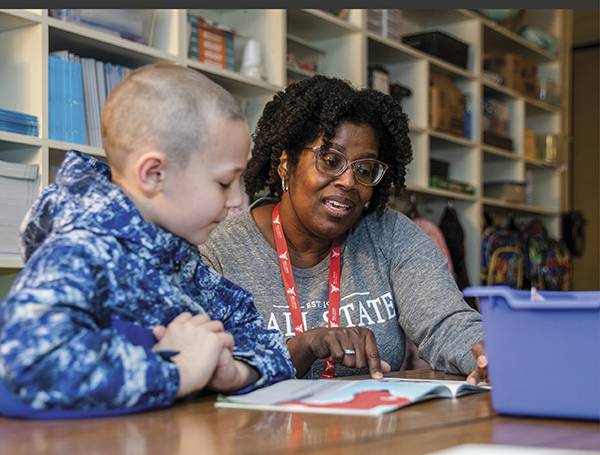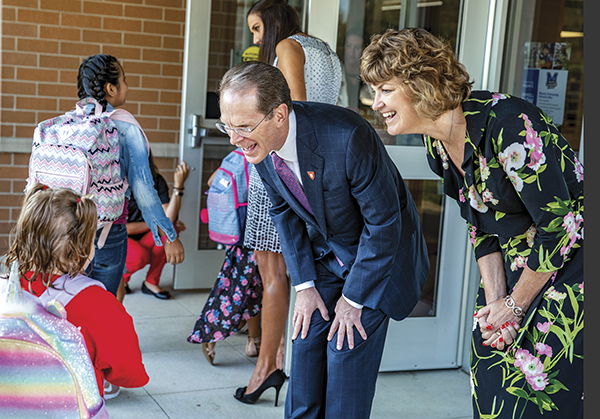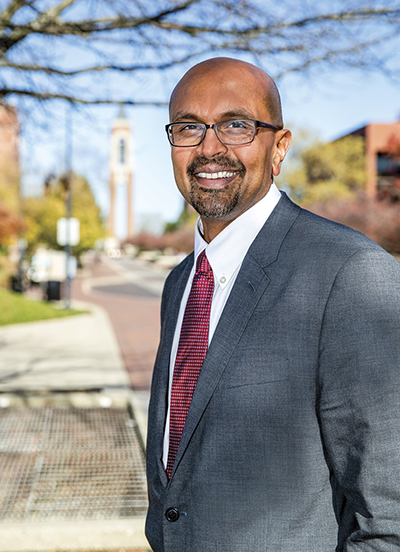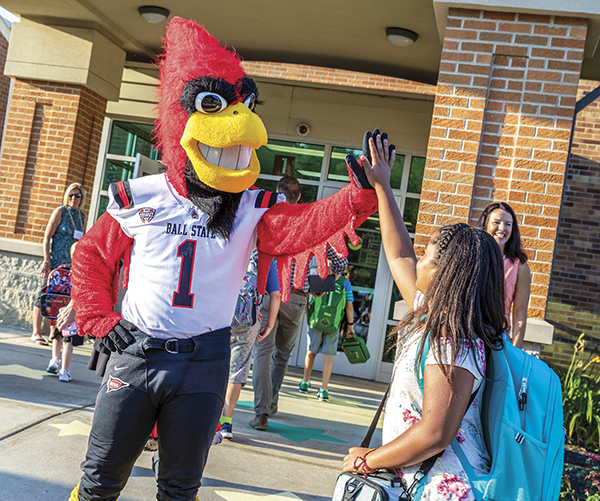Resuscitated by Its University Neighbor
May 01, 2023
Appears in May 2023: School Administrator.
In a distinctive governing arrangement advancing town-gown relations, Ball State University is managing Muncie Community Schools back to fiscal health and more promising academic results

Eldred Coleman Jones has noticed in recent years her five children in Indiana’s Muncie Community Schools have more projects and field trips and learn more on their Chromebooks and iPads.
“There is so much help for them,” she says, approvingly.
Kelly Agnew, a 4th-grade teacher at Muncie’s West View Elementary School, has seen pay raises each of the last four years. She’s also received continual professional development to help her and her school offer more innovative student-centered, hands-on learning.
“I see in some of my students their confidence building,” she says.
Meanwhile, North View Elementary Principal Aiesha Allen each week welcomes into her school an education professor who provides instructional resources, welcome advice and relevant training to Allen’s staff. The professor also brings along 46 university students twice a week to help teachers with small-group and one-on-one tutoring.
“With all these people coming together,” Allen says, “we’ve seen a lot of positives.”
Capacity to Control
This mother, teacher and principal are recognizing the fruits of one of the nation’s most unusual experiments in public school governance: a state university’s wholesale oversight of its town’s public school system.
After the Indiana Legislature paved the way with its approval in 2018, Ball State University President Geoffrey Mearns proposed his 22,000-student institution appoint the members of the school board and run Muncie Community Schools, a financially and academically struggling school district. Mearns, a Yale-educated English major who spent 17 years practicing law, and his university board of trustees concluded helping the public schools was a smart way to engage the community and support its 65,000 residents.
“We wanted to have more capacity to control our destiny, both of the schools and of the university,” Mearns says.
The Ball family, industrialists who manufactured their Ball canning jars in Muncie, founded Ball State in 1918 as a teachers college. With those roots, Mearns says, it was logical for the university “to employ more of its expertise and human capital to support a local school district.”
It’s exceedingly rare for a public university to take charge of the governance and operations of a public school district. But the distinctive partnership does reflect a growing trend among colleges and universities to break town-gown barriers by getting more intimately involved in improving the civic and economic lives of their communities.
A Desperate District
The industrial decline that swept Middle America in the 1970s hit Muncie hard. The school district’s tax base shrank. Enrollment dropped from nearly 20,000 in 1967 to about 5,000 today. Student performance on state tests declined to among Indiana’s lowest. Over the 10 years ending in 2017, the district closed buildings, lost teachers, chalked up $36 million in deficits and funneled $10 million from a bond repair fund to pay for operations.
The Indiana Legislature put the school district into state receivership and let Ball State assume control in July 2018. Lawmakers gave Mearns authority as university president to appoint a seven-member school board for Muncie schools. About 90 candidates applied. With help from the mayor and city council, Mearns whittled the pool to 20 contenders who participated in a televised forum in a high school auditorium. Mearns subsequently named the seven board members.
The new board appointed Lee Ann Kwiatkowski — former teacher, administrator and senior education adviser to Indiana Gov. Eric Holcomb — to lead the district with the title of director of public education and CEO rather than superintendent. Nothing has made a bigger difference in improving the district than allowing Mearns to appoint the board, Kwiatkowski says. The diverse board has multiple skills, strong ties to Muncie, community support and a sharp focus on student success.
A Partnership’s Pillars
As Ball State leaders embarked on what they prefer to call a partnership rather than a takeover, they asked the state Legislature to give them two years to map a strategic plan. They wanted time to build trust, Mearns says, to listen to teachers, to families and to community leaders. The partnership organized public forums and panels of Muncie teachers, Ball State professors and national experts to chart the best path forward.
Anand Marri, dean of Teachers College at Ball State, began talking with Kwiatkowski several times a week to help her manage the district.
“My job is to help them find resources and solve problems,” says Marri, who previously spent five years as a vice president with the Federal Reserve Bank of New York.
University staff wrote grants for more money for the district, and Teachers College sent faculty to serve as professional development liaisons, one for 10 hours a week in each of the six elementary schools and two more shared by two middle schools and one high school. Faculty brought along college students who helped tutor, teach and counsel. Eventually, all seven of Ball State’s academic colleges pitched in with faculty and students to help Muncie students in everything from outdoor summer school to the study of journalism.
In 2022-23, the partnership is executing the second year of its five-year strategic plan, which focuses on five pillars:
High-quality pre-kindergarten education,
Recruitment and retention of teachers and administrators,
Student-centered teaching and active learning,
Social and emotional learning, and
Family and community engagement.
Early Payoff
The latest report on the strategic plan documents significant progress on every pillar. The partnership stabilized student enrollment, boosted teacher retention from 67 percent to more than 80 percent and engaged faculty, teachers and staff in various new committees and work groups. Ball State raised $5 million in philanthropic investments and $13 million in competitive grants for Muncie’s schools, helping to steady the district’s finances. The Muncie system now has a $35 million cash balance and a $12 million rainy day fund.
The district expanded preK classrooms in the elementary schools, tripling enrollment from 50 to 156 students. (See related story below.)
Muncie’s school board rejected collective bargaining with the teachers’ union. But it did raise teacher pay over each of four years by a cumulative 40 percent, including a 15 percent bump this year. These increases came after teachers worked without any raises for nine years.
University faculty and consultants helped teachers shift from traditional classroom practices toward project- and inquiry-based active learning.
“There is no one silver bullet, but hands-on, engaged activities tied to rigorous state and national standards are key,” says Marri, the Teachers College dean who joined Ball State in 2020.
Muncie schools adopted flexible seating arrangements and a literacy and math curriculum with best practices for students in kindergarten through middle school. They also hired art and music teachers.
The new instructional approaches are reflected in a program the district will launch with a $1.5 million U.S. Department of Education grant to Ball State to improve civic education. The program will integrate instruction in geography, government and media literacy and engage students in an academy, student-designed projects and field trips. It even will offer an annual civic learning symposium that students can participate in with teachers and national experts.
Muncie schools increased dual credit courses and enrollment in a variety of special academic programs such as the high school’s Project Lead the Way, which focuses on science, math and computers.

To enhance social and emotional learning and community engagement, the district established a health clinic at one middle school that in its first two years handled 3,442 student visits.
Financial, staff and enrollment stability “has been huge” in providing a source of pride for the schools and community, says Agnew, the West View 4th-grade teacher, who grew up near Muncie and graduated from Ball State.
“It has been a while since people were proud of Muncie schools,” she says.
A Parent’s Perspective
Partnership educators know they have a long way to go, especially with student achievement. Only about one in five Muncie students, compared to two in five statewide, are meeting proficiency in math, reading, social studies and science on state exams.
As the mother of five children in Muncie schools now and four older children who previously attended them, Eldred Coleman Jones has a broad perspective on the partnership. She’s also a graduate of Ball State and works as a behavior coach in one of Muncie’s elementary schools. She sees more support and relevant instruction.
“The kids are being shown by the projects they are doing in class how this is going to apply to their lives,” she says.
The partnership gives hope to long-underserved children and families, says James Williams, a lawyer and president of the Muncie school board. “This has been the most meaningful, important work in my career.”
University Benefits
The partnership also is bearing fruit for the university. The Muncie schools’ improvements have helped the university and community attract and retain faculty, workers and students, Mearns says. The university also is using dual enrollment credits and other incentives to lure Muncie graduates to Ball State.
Marri says faculty at Teachers College get valuable “boots on the ground” experience in public school classrooms that keeps their teaching and research connected to the reality of urban schooling.
“This is a way to take all the research and put it into practice,” he says. “We are able to practice what we preach.”
The university also has become much more engaged with the community. “There is a huge connection between town and gown now that was not previously present,” Marri says. Making that connection is “a moral imperative” more and more universities are recognizing, he adds.
“If you can’t help the community you are working in,” he says, “what is the point of the common good?”
Recalling Chelsea
Many colleges and universities have been involved in public education projects over the years. Scores run charter schools or public laboratory schools. The 5,000-student private Butler University in Indianapolis, Ind., is partnering with Indianapolis Public Schools to operate two laboratory schools and an International Baccalaureate high school in the district. Researchers at the University of Michigan, Harvard Graduate School of Education and other groups created the Boston Early Childhood Research Practice Partnership in 2007 to help Boston Public Schools evaluate and improve its preK program.

In a dozen interviews, higher education officials, including those at Ball State, say they are unaware of any other university taking charge of an entire public school district as Ball State has done. But it’s not unprecedented.
In 1988, the Chelsea Public Schools outside Boston was in financial crisis with crumbling buildings and low graduation rates. Leaders of the 3,400-student district asked the private Boston University to take over management for 10 years. It did so for 20. The university stabilized Chelsea finances, built seven new schools, nearly doubled enrollment, overhauled the curriculum, trained teachers, expanded preK and added arts and music. Test scores for Chelsea’s diverse, low-income students climbed significantly, but remain below state average and district goals.
Douglas Sears, vice president and chief of staff to the president of Boston University, served as superintendent of Chelsea schools from 1995 to 2000. He says some of the most important support for the district came from the university’s finance and budget staff and from listening to Chelsea educators.
“It is important that those who think of themselves as experts need to be humble enough to listen,” he says.
The 20-year project was expensive for Boston University and benefitted it “only in spiritual terms,” Sears says, adding that universities are feeling more pressure from their communities to get involved in solving civic problems.
At the University of Virginia’s Institute for Advanced Studies in Culture, the Thriving Cities Lab wrote in 2019 that the nation has seen a “burgeoning movement of university-community partnerships.” The lab, a nonprofit that studies ways to improve urban life, reported at least 85 percent of 100 universities it surveyed had stated commitments to helping their local communities.
Possible Model
Several of the leaders directly involved see the Ball State-Muncie schools’ partnership as a worthy model for other university-district partnerships. “I absolutely do,” says Kwiatkowski, Muncie’s CEO. The commitment among the university, community and public schools to work together “can be a game changer,” she adds.

Williams, the Muncie board chair, says he was attracted to the partnership as “an innovation, an experiment that gave a model perhaps for other communities to work with. … I would love to think it is replicable.”
Based on what he experienced with the Chelsea takeover, Sears believes universities are too ideological for him to recommend they get involved running public schools at this time. Mearns also is not so sure they should get involved.
“Not every district that needs support has a large public university in its neighborhood,” he says. “We’re pretty modest about whether this can become a pathway.”
But it’s a path he’s going to keep traveling. Student achievement is the hardest needle to move, Mearns says. “We know producing the academic performance we want is going to take some time.”
Until that happens, he says, no one is ready to talk about ending the partnership.
Bill Graves is an education freelance writer in Beaverton, Ore.
 Higher education research long has supported preschool expansion in public schools, but rarely do universities take full charge of a school district and expand pre-kindergarten as Ball State University has done.
Higher education research long has supported preschool expansion in public schools, but rarely do universities take full charge of a school district and expand pre-kindergarten as Ball State University has done.
After the Indiana Legislature gave the 22,000-student university authority in 2018 to run Muncie Community Schools, the university and district developed a strategic plan that makes expanding pre-kindergarten the first of its five goals.
Over two years, the district has added five preK classrooms, tripling enrollment to 156. It also upgraded preK teachers’ training and credentials. The program is thriving, says Aiesha Allen, principal of North View Elementary School. “So many parents want to enroll their students,” she says, noting she has 25 children on her school’s waiting list. “It is so important.”
The district is about halfway toward its goal of offering preschool space for every eligible child, says Lee Ann Kwiatkowski, the district’s director of public education and CEO.
Supporting Role
Universities are becoming more community engaged, and it would not be surprising to see more get directly involved in expanding public preschool classes, says W. Steven Barnett, professor and co-director of the National Institute for Early Education Research at Rutgers University in New Jersey.
Some universities help run federal Head Start preschool for low-income children and other preK classes in charter and laboratory schools. But higher education more commonly provides a supporting role of professional development and evaluation for public preschool expansions, Barnett says.
His institute provides evaluation across New Jersey, which continues to expand its preschool classes in public schools, he says. Universities also provide support to New York City’s recently established public preschools.
In the Boston Early Childhood Research Practice Partnership launched in 2007, researchers at the University of Michigan, Harvard Graduate School of Education and other groups are helping Boston Public Schools study preK practices. Researchers help Boston schools “evaluate their model and how to make it stronger,” says Christina Weiland, a professor at the University of Michigan’s Marsal Family School of Education.
Research Backing
University researchers attest to early education’s power. “Much of the impetus for early childhood education comes from research that goes back to the ’60s,” Barnett says.
Edward Zigler, a psychology professor and director of the Child Study Center at Yale University, played a key role as director of the U.S. Office of Child Development in expanding Head Start, part of President Lyndon Johnson’s War on Poverty, into a full-day program that has served 30 million disadvantaged children.
The Carolina Abecedarian Project from the Frank Porter Graham Child Development Institute of the University of North Carolina at Chapel Hill in the early 1970s revealed lifelong benefits of quality preschools. The results continue to be influential.
“You don’t have to be an expert in education to understand the value of high-quality preK,” says Geoffrey Mearns, Ball State’s president. “If children are not kindergarten ready, that is a significant headwind for them ever being able to graduate from high school.”
— Bill Graves From a young age, my parents instilled in me the belief that every child has a fundamental right to a quality education. This belief has shaped my personal commitment to support Ball State University’s innovative partnership with Muncie Community
Schools.
From a young age, my parents instilled in me the belief that every child has a fundamental right to a quality education. This belief has shaped my personal commitment to support Ball State University’s innovative partnership with Muncie Community
Schools.
As president of Ball State, I embraced our institution’s professional commitment to the partnership, now in its fifth year, for several compelling reasons.
The first was that our university was uniquely qualified to assume this responsibility. Ball State has a history of preparing teachers that dates back to our founding as a teachers college in 1918. Education is central to what we do — and to who we are.
The second reason was that, in addition to being our core mission, this new responsibility was consistent with our institutional interest. The future of Muncie depends on the quality of its public schools, and our university’s future depends on a vibrant Muncie.
Third, Ball State accepted this responsibility because I believed in 2018 when we launched this partnership, as I do now, that we have a moral obligation to support the people of Muncie — the same people who have played a vital role in the growth of our university.
A Catalyst, Not a Roadmap
One example of the community’s exceptional support for Ball State involves the construction of our on-campus auditorium, a regional destination for arts and entertainment. The auditorium was built in the early 1960s for $3 million — half of which was raised by the community.
More than 40 local employers in Muncie instituted payroll deductions and, for two years, many factory workers gave $5 of every paycheck to support the venue’s construction. John Emens, then-president of Ball State, even solicited paperboys to support the cause. Emens informed the paperboys that, by giving just 25 cents, they would help pay for one of the bricks needed to build the auditorium. Recently, one of those paperboys, long retired from his delivery route, told me that whenever he drives past the auditorium, he recalls contributing 75 cents to buy three bricks to make the president’s vision a reality.
The story of Emens Auditorium illustrates the extraordinary relationship our university has with our community. It’s this extraordinary relationship that makes Ball State’s partnership with the public school system so special.
Our favorable experience, though, is not necessarily a specific road map for other communities and universities, because each school district and each university is different. Rather, our experience teaches us that a university can serve as a catalyst, tapping its own and its community’s unique resources — human and financial — to support its local public schools.
Historic Chance
In the center of our campus stands a bronze statue named Beneficence. This statue was a gift from the people of Muncie who, during the Great Depression, raised $450,000 toward its construction in appreciation for the Ball brothers, whose land donation to the state allowed Ball State to flourish.
Today, Beneficence is our icon — the embodiment of our commitment to the enduring values that are a hallmark of our institution, including the value of gratitude.
So when our university was presented with the historic opportunity to partner with Muncie Community Schools, I wanted us to demonstrate our gratitude to the city we call home. In doing so, our university is contributing our expertise and our innovative academic programs to a school district that, once distressed, is now firmly on the path to a brighter future.
Geoffrey Mearns is president of Ball State University in Muncie, Ind. @PresidentMearns
One of the most powerful forces improving Muncie Community Schools in recent years has been the appointment of the school board, says Lee Ann Kwiatkowski, who heads the district.
Ball State University President Geoffrey Mearns appointed the seven-member board, which hired Kwiatkowski to be director of public education and CEO, essentially functioning as the superintendent. The Indiana Legislature in 2018 gave Ball State authority to appoint the board and run the financially and academically distressed school district.
Mearns, in a highly publicized process, appointed a diverse and effective board with multiple skills, strong ties to Muncie, community support and a sharp focus on student success, Kwiatkowski says. All but one of five men and two women on the board live in the city and attended Muncie schools. Five are white, two Black, and the group includes a YWCA executive director, a lawyer, a banker, a Ball State special education professor, a pastor and a former judge. One board member is Ball State’s facilities planning vice president, which is like having a free consultant, Kwiatkowski says.
Elected — rather than appointed — school boards govern the vast majority of the nation’s 13,452 public school districts. Some school boards have long been appointed by mayors, county boards or other elected officials, but in most cases, districts end up with appointed boards only after they have fiscal, mismanagement or academic problems that lead officials to replace their elected bodies.
Some boards end up with a mix of appointed and elected members, says Renee Joe, chief marketing and communications officer for the National School Boards Association. In Maryland, where 75 percent of school board members are elected, the Baltimore City Board of School Commissioners is appointed by the mayor, and four school boards in the state have a combination of appointed and elected members, she says.
“The number of appointed boards seems very small, but there is an increasing trend that school board members can be appointed by mayors and county governments,” Joe stated via e-mail.
The precise number of appointed board members is difficult to pinpoint. In a 2010 study for NSBA, Frederick Hess and Olivia Meeks found 95 percent of school board members were elected. In a more recent 2018 NSBA survey of school board members, 12 percent of respondents reported being appointed. But this relies on respondents who chose to answer the survey, so the true estimate of appointed school board members is hard to know, says Michael Hartney, a Boston College political science professor.
Accountability Questions
Having the power to choose board members enabled Mearns to build a diverse and balanced board with complementary skills. The board quickly stabilized district finances, improved student and teacher retention and developed a strategic instructional plan.
Mearns and Muncie schools did not have to deal with elected board members pushing political agendas, such as those backed in the past year by Moms for Liberty. The conservative Florida-based parent group last year successfully supported school board candidates who challenge the way schools teach about sex, race, gender and U.S. history.
The Muncie school board has been successful because its “No. 1 goal is student success” and it’s “not beholden to any group,” says Anand Marri, dean of Teachers College at Ball State.
On the other hand, if problems develop in the district, taxpayers cannot easily hold the board accountable, says Thomas Gentzel, former executive director of both the NSBA and the Pennsylvania School Boards Association. In most cases, he says, an appointed board is selected by elected officials — a governor, mayor, county commission — which means “you have already moved it one level from the voters.”
In the Muncie case, with a non-elected college president making appointments, the authority is even “further removed from the people,” Gentzel says. “The whole school system is being run from the university. What elected official has to answer for the decisions being made?”
Mission First
The Muncie school board’s success lies in its clear grasp of its mission, says James Williams, board president and a former state circuit court judge.
“There is a level of urgency to us getting this right, to improving, to making progress every day,” he says. “We’re simply not rich enough to have 30 percent of the population functioning only marginally on the fringes of the economy.”
But it doesn’t follow that school boards should be appointed, he says, adding that elected or not, “the vast majority of board members truly desire for students in their charge to receive a first-rate education.”
— Bill Graves
Author
Advertisement
Advertisement
Advertisement
Advertisement



